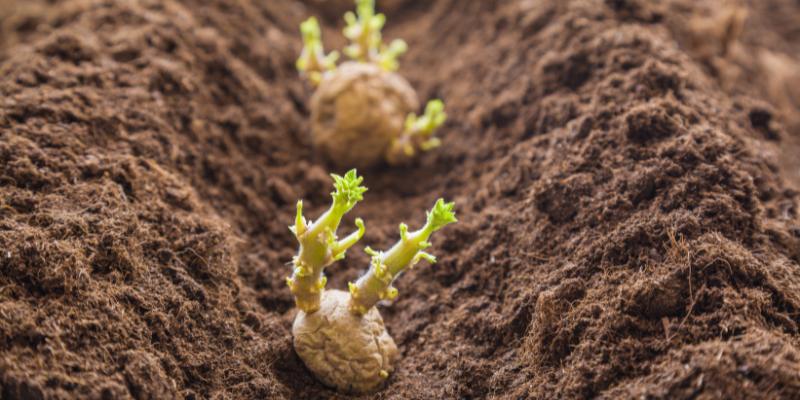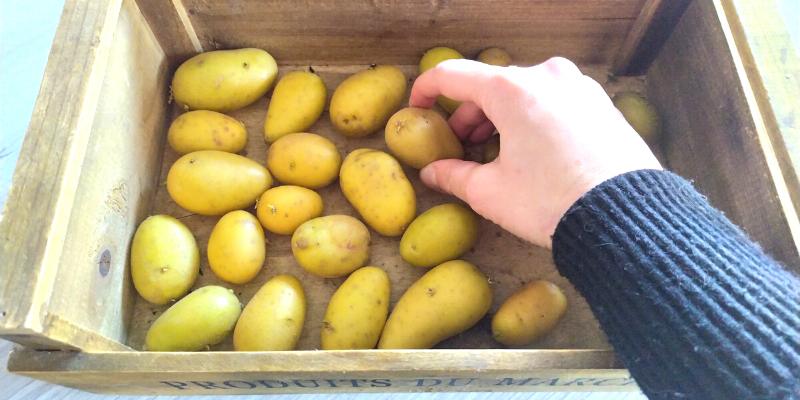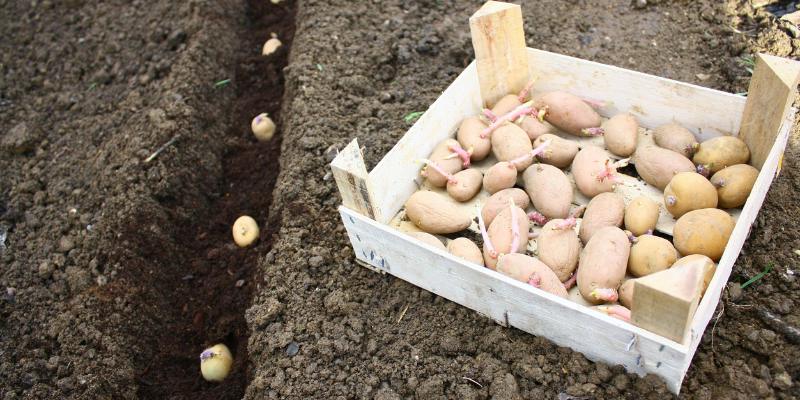Should you chit potatoes before planting? Well yes! To obtain a good potato harvest, it is important, even almost essential, to chit your potatoes before growing them in the vegetable patch. Indeed, planting chitted potatoes gives a much better yield than planting directly in open ground. In addition, chitting potatoes shortens growing time, allowing you to gain a few precious weeks for crop rotation. Discover our tips and tricks to chit your potatoes.

When should you chit potatoes?
Chitting takes between 4 and 6 weeks. So you should start chitting your potatoes about a month before the planned planting date.
Generally, new potatoes are chitted between January and March, for planting from February to April under cover (greenhouse or polytunnel), depending on your region.
Maincrop potatoes and other varieties are chitted between February and April, for planting in the garden between March and May depending on your climate.
| Type of potatoes | Region | When to chit? | When to plant? |
|---|---|---|---|
| New potatoes | Mild regions (South) | Between January and February | From February, under cover (greenhouse or polytunnel) |
| New potatoes | Cool regions (North) | Between February and March | In April, under cover |
| Maincrop potatoes | Mild regions (South) | In February and March | In March–April in open ground |
| Maincrop potatoes | Cool regions (North) | In March and April | In April–May in open ground |
How to chit potatoes?
1- Place your potato tubercles in a wooden tray or crate without stacking them, with the eyes (small spots visible on the tubercle's skin) facing up. If your tubercles already have small shoots, place them with the shoots facing up too.
Tip: you can also chit potatoes in a cardboard egg tray.

2- Then place your crate of potatoes to chit in a light spot, preferably in an unheated, frost-free room, if possible ventilated, at a temperature between 10 and 15 °C.
3- You should then see the first potato shoots appear within a few days.
When to plant chitted potatoes?
After 4 to 6 weeks, your tubercles will have shoots 2 to 3 cm long. You can then plant them under cover or in the garden when soil temperatures are above 10 °C.
Earth up chitted potatoes regularly as they grow to protect them from cold and feel free to add mulch (hay, straw or dry grass clippings).
Tip: A good way to tell when to plant chitted potatoes outdoors is to watch lilacs: when they are in flower, it is the right time to plant potatoes in open ground!

Questions and tips for chitting potatoes
Why should you chit potatoes before planting?
Chitting potatoes before planting has several advantages:
- Speed up growth: Tubercles have already started their growth cycle, which allows quicker emergence once planted.
- Improve yield: Chitted potatoes generally produce more stems, which can lead to better tubercle production.
- Reduce disease risk: During chitting, you can discard soft, mouldy or diseased tubercles. This allows you to plant only healthy potatoes and limit disease risk in the soil.
Can you plant non-chitted potatoes?
It is perfectly possible to plant non-chitted potatoes directly in the ground, but development will then be slower. In addition, yield may be lower, because cooler garden temperatures can slow shoot growth. Finally, excess soil moisture or heavy rain can rot some tubercles before they sprout.
Can you chit supermarket potatoes?
Yes, it is possible to chit potatoes bought for consumption, but it is not always recommended. Potatoes sold in supermarkets are often treated to slow sprouting and will therefore take longer to chit. In addition, they can carry diseases into the vegetable patch and are not selected for garden performance.
For those wishing to try, favour organic, untreated potatoes. However, for best results, it is recommended to opt for seed potatoes specially intended for cultivation.
Other tips for chitting potatoes
- You can place some absorbent paper, a cloth or newspaper under the potatoes while chitting to absorb moisture and thus limit mould growth.
- Large potatoes can be cut in half for the chitting phase. Place the cut side down and the tubercle's eyes facing up. This way you will obtain not one but two young potato plants.
- You can replace the tray or wooden crate with the compartments of an egg box. These compartments allow proper positioning of potatoes that already have small shoots facing up and avoid disease spread through contact.

- During chitting, do not hesitate to remove soft potatoes or those showing signs of disease or rot.
- If you do not have an unheated room, you can simply put your crate of potatoes in the sun during the day and store it in the garage, cellar or indoors at night.
- Also find our video on growing potatoes under mulch:






























![To sprout potatoes [planting_guide title="How to Sprout Potatoes for the Vegetable Garden"]
To sprout {glossary}potatoes{glossary}, start by placing them in a bright, cool location for a few weeks. Once they have developed short sprouts, cut the potatoes into sections with at least one sprout each. Leave the cut pieces to dry for a day or two to prevent rotting. Then, plant the sprouted sections in well-draining soil, ensuring the sprouts are facing upwards. Water the newly planted potatoes regularly and wait for them to grow into healthy plants ready for your vegetable garden.
[/planting_guide]](https://en.promessedefleurs.eu/blogwp/wp-content/uploads/2022/12/Faire-germer-des-pommes-de-terre-1.png)
Comments